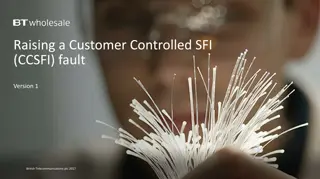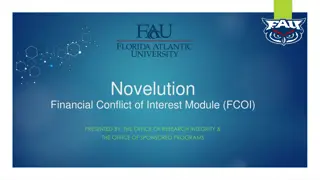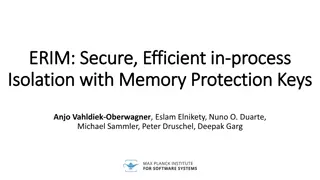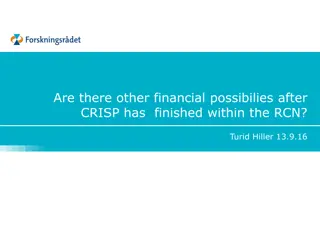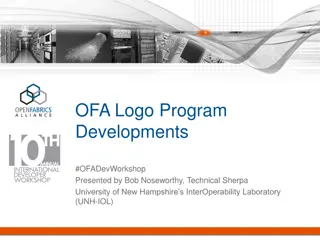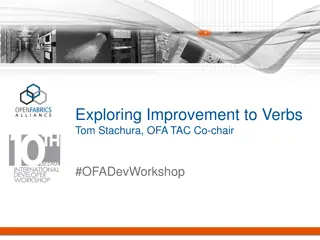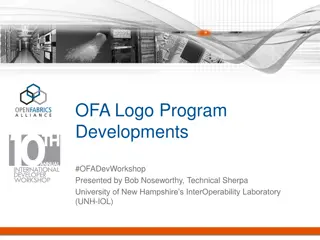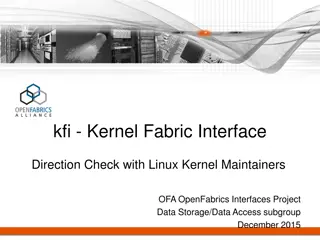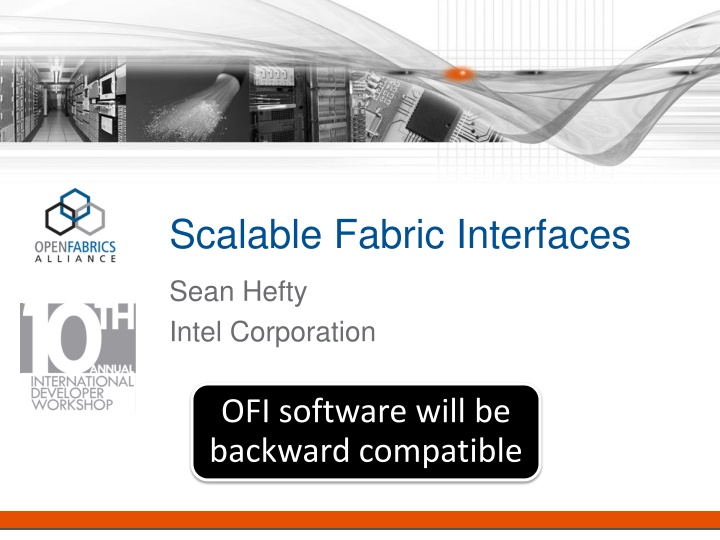
Enhancing Application Scalability through Scalable Fabric Interfaces and Communication Optimization
Discover how Scalable Fabric Interfaces and optimized communication protocols contribute to application scalability, with a focus on minimal footprint, high performance, and extensibility. Learn about key concepts such as API impact, reliable data transfers, application-driven communication models, and address vector management.
Download Presentation

Please find below an Image/Link to download the presentation.
The content on the website is provided AS IS for your information and personal use only. It may not be sold, licensed, or shared on other websites without obtaining consent from the author. If you encounter any issues during the download, it is possible that the publisher has removed the file from their server.
You are allowed to download the files provided on this website for personal or commercial use, subject to the condition that they are used lawfully. All files are the property of their respective owners.
The content on the website is provided AS IS for your information and personal use only. It may not be sold, licensed, or shared on other websites without obtaining consent from the author.
E N D
Presentation Transcript
Scalable Fabric Interfaces Sean Hefty Intel Corporation OFI software will be backward compatible
OFI WG Charter Develop an extensible, open source framework and interfaces aligned with ULP and application needs for high-performance fabric services 2
Enable.. High performance Minimal footprint Optimized software path to hardware Reduced cache and memory footprint Independent of hardware interface, version, features Extensible App-centric More agile development Analyze application needs Time-boxed, iterative development Application focused APIs Adaptable Implement them in a coherent, concise, high-performance manner 3
How can an API affect application scalability? Minimal footprint I m glad I asked. 4
Communication Reliable data transfers, zero copies to thousands of processes struct rdma_route { struct rdma_addr struct ibv_sa_path_rec *path_rec; ... }; Src/dst addresses stored per endpoint addr; 456 bytes per endpoint Path record per endpoint struct rdma_cm_id {...}; rdma_create_id() rdma_resolve_addr() rdma_resolve_route() rdma_connect() Resolve single address and path at a time All to all connected model for best performance 5
Scalable Communication Application driven communication models Reliable unconnected transfers Abstract hardware features SRQ, XRC, dynamic connections Optimize addressing Resolve multiple resolution requests at once Compact address data storage Compressed address ranges, path data Support multiple resolution mechanisms Optimized for different topologies and fabric sizes 6
SFI - Address Vectors Store addresses/host names - Insert range of addresses with single call Share between processes Example only Reference entries by handle or index - Handle may be encoded fabric address Reference vector for group communication Start Range End Range Base LID SL host10 host1000 50 1 host1001 host4999 2000 2 Enable provider optimization techniques - Greatly reduce storage requirements 7
Can API changes unlock higher performance? High performance Just a guess, but is the answer yes ? 8
Application Send Significant SW overhead Application request struct ibv_sge { uint64_t uint32_t uint32_t }; addr; length; lkey; <buffer, length, context> 3 x 8 = 24 bytes of data needed SGE + WR = 88 bytes allocated struct ibv_send_wr { uint64_t struct ibv_send_wr *next; struct ibv_sge *sg_list; int enum ibv_wr_opcode opcode; int uint32_t ... }; wr_id; Requests may be linked - next must be set to NULL num_sge; Must link to separate SGL and initialize count send_flags; imm_data; App must set and provider must switch on opcode Must clear flags 28 additional bytes initialized 9
Provider Send Most often 1 (overlap operations) For each work request Check for available queue space Check SGL size Check valid opcode Check flags x 2 Check specific opcode Switch on QP type Switch on opcode Check flags For each SGE Check size Loop over length Check flags Check Check for last request Other checks x 3 Often 1 or 2 (fixed in source) Artifact of API QP type usually fixed in source Flags may be fixed or app may have taken branches 19+ branches including loops 100+ lines of C code 50-60 lines of code to HW 10
Scalable Transfer Interfaces Application optimized code paths based on usage model Optimize call(s) for single work request Single data buffer or 2-entry SGL Still support more complex WR lists/SGL Per endpoint send/receive operations Separate RMA function calls Pre-configure data transfer flags Known before post request Select software path through provider 11
SFI Send Message 50-60 lines of C-code 25-30 lines of C-code Allocate WR Allocate SGE Format SGE 3 writes Format WR 6 writes Reduce setup cost - Tighter data Direct call 3 writes optimized send call Checks 2 branches generic send call Loop 1 Checks 3 branches Eliminate loops and branches - Remaining branches predictable Checks 9 branches Loop 2 Check Loop 3 Checks 3 branches Selective optimization paths to HW - Manual function expansion 12
Completions Application accessed fields struct ibv_wc { uint64_t enum ibv_wc_status status; enum ibv_wc_opcode opcode; uint32_t uint32_t uint32_t uint32_t uint32_t int uint16_t uint16_t uint8_t uint8_t }; wr_id; App must check both return code and status to determine if a request completed successfully vendor_err; byte_len; imm_data; qp_num; src_qp; wc_flags; pkey_index; slid; sl; dlid_path_bits; Provider must fill out all fields, even those ignored by the app Provider must handle all types of completions from any QP Developer must determine if fields apply to their QP Single structure is 48 bytes likely to cross cacheline boundary 13
Scalable Completion Interfaces Application optimized code paths based on usage model Use compact data structures Only needed data exchanged across interface Limited to fields required by application Separate addressing from completion data Report errors out of band Per CQ operations Support multiple wait objects Allow provider to optimize event signaling 14
SFI Events App selects completion structure Generic completion Op context read CQ optimized CQ +1 write, +0 branches Support provider updating counters Send: +4-6 writes, +2 branches Recv: +10-13 writes, +4 branches 15
Is there anything else behind this proposal? App-centric I have two more puzzle pieces. 16
Application Interface Mismatch 1600 1393 1327 1400 Instructions retired in MPI_Isend 1200 Instructions Retired 518 (lower is better) 518 1000 800 600 875 809 400 Lookup connection, check memory registration, formatting requests, etc. 200 0 MVAPICH2-Dynamic-Link MVAPICH2-Static-IPO-Link MPI_Isend Verbs MVAPICH2-2.0rc1 (latest) code is used with default configuration options (CH3:mrail) All userspace instructions are counted for full execution of MPI_Isend Memory copies and locks are also included in the component that uses them MVAPICH2 lib compile flags: -O3 DNDEBUG ipo App compile flags: -O3 DNDEBUG ipo -finline-limit=2097152 -no-inline-factor -inline-max-per-routine=10000000 -inline-max-per-compile=10000000 -Bstatic -lmpich -Bdynamic -lopa -lmpl -libverbs -libumad -libmad -lrdmacm -lrt -lpthread 17
Application-Centric Interfaces Reducing instruction count requires a better application impedance match Collect application requirements Identify common, fast path usage models Too many use cases to optimize them all Build primitives around fabric services Not device specific interface 18
Application-Centric Interfaces Myth: app-centric interfaces imply more overhead Poor implementations result in poor performance Difficult to use APIs are likely to result in poor implementations Provider knows best method for accessing their HW These are still low-level interfaces (C), just not device interfaces (assembly) 19
Application Configured Interfaces Communication type App specifies comm model Provider directs app to best API sets Capabilities Endpoint Data transfer flags sm. msg lg. msg RMA write send inline send read RMA Ops Message Queue Ops NIC 20
Whats the purple piece representing again? Extensible 21
Extensible Framework Focus on longer-lived interfaces software leading hardware Take growth into consideration Reduce effort to incorporate new application features Addition of new interfaces, structures, or fields Modification of existing functions Allow time to design new interfaces correctly Support prototyping interfaces prior to integration 22
Future Extensions Design framework and APIs with anticipated capabilities Stage delivering features Documentation defines supported usage models Use static inline calls to simplify application interactions with objects Convert object-oriented model to procedural model 23
Claim These concepts are necessary, not revolutionary Communication addressing, optimized data transfers, app- centric interfaces, future looking Want a solution where the pieces fit tightly together 24
Thank you! 25

